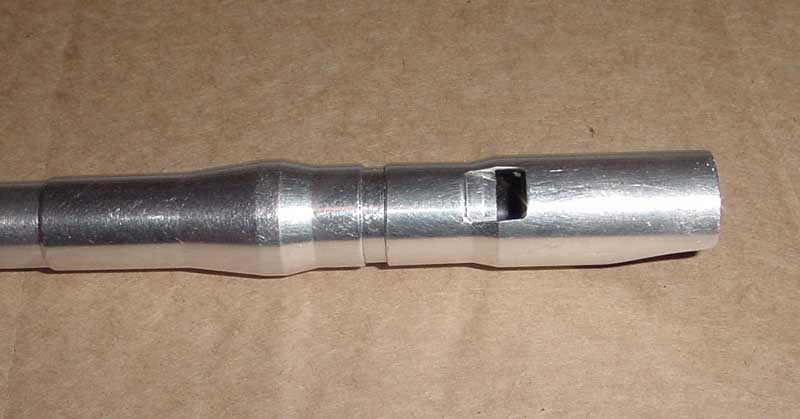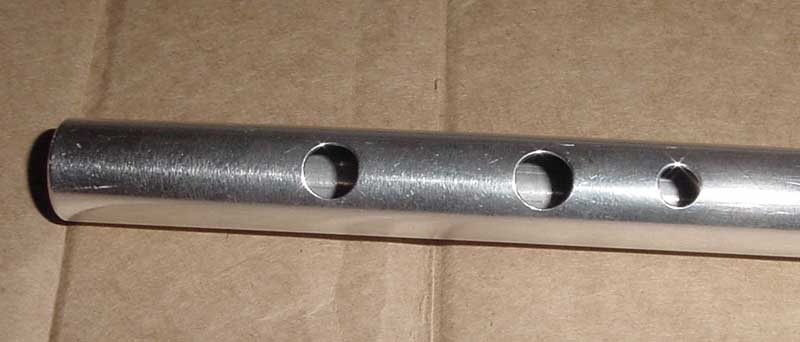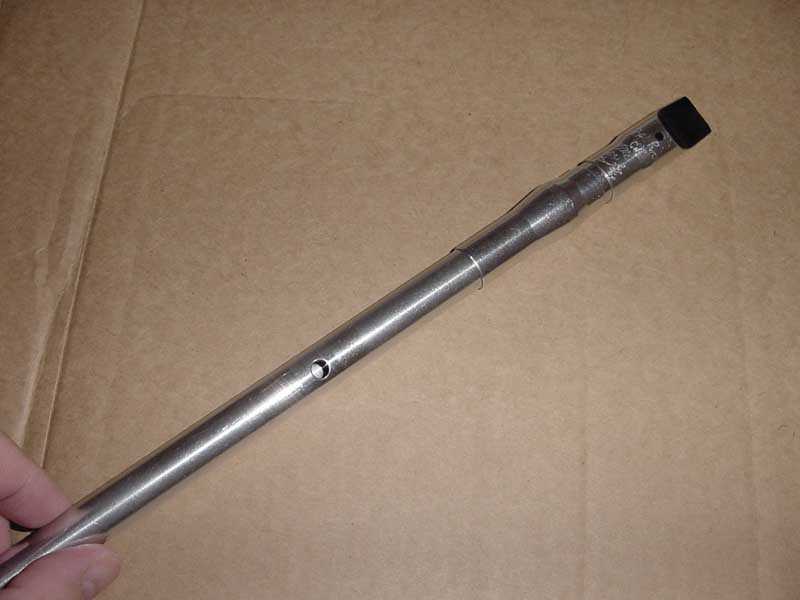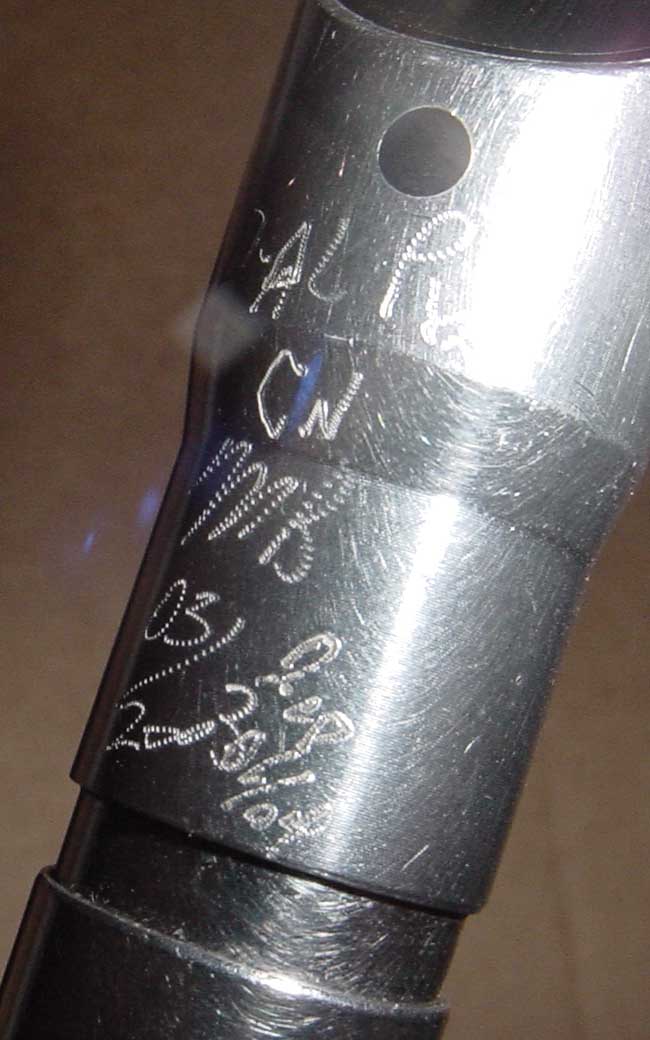Burke Al-Pro with C-natural thumbhole Review
(Review written June 2005)
- Preface
-
In 2003, I had a Burke Al-Pro and really loved it. It had a sweet tone, and was really easy to play. I took it everywhere. And then I lost it for about two months (it turns out it was in a neighbors couch!), and so was forced to get used to the breath requirements of the Copeland I had, for gigs. After that, I didn't play the Burke as much, and I ended up selling it to help fund my move to Dallas.
When I saw one for sale in late 2004 at a decent price on The Chiff & Fipple board I snapped it up.
- At a Glance
- Whistle Reviewed
- Burke Al-Pro with C-natural thumbhole
- Models Available
- Michael Burke makes whistles in brass, composite, and aluminum, in a variety of styles (session, narrow bore, etc) and keys.
- How Acquired
- Bought secondhand.
- Construction
- Aluminum with Delrin fipple
- Price at Time of Review (in US Dollars unless otherwise noted)
- $150.00
- Available From
-
Michael Burke Pennywhistle Company
- Appearance
-
Mike's whistles are made on CNC (Computer Numerical Control) machines, so they're crafted with a high degree of precision. In addition, Mike says that the whistles are still fine-tuned and voiced by hand. Like Sweetheart whistles, they have a bit of a bulge as part of the tuning slide construction. This helps give them a very recognizable
and unique look. The Al-Pro is evidently not being sold any more, evidently being replaced by the DAS (D Aluminum Session model), and later replaced by the DASBT (D Aluminum Session Model Black Tip). Mike's catalog numbering can be a little overwhleming at first, but if you stop and take time to absorb it all, it all falls into place. This whistle is similar in tone and looks to other Burkes I've tried, so it should help you decide if it's for you, even if this specific model isn't made any more.
It's interesting to note that Mike's whistles have a "purturbed bore". You can't really see it by looking at it, but Mike slightly constricts or exapands the inner bore of the whistle in various places, to help with tuning, volume, and to help strengthen the low notes.
-

Here's the full whistle. I always felt a little bit like the Burke looked like a whistle that swallowed a grape, owing to the tuning slide bulge. Cute! As we get into the closeups, It'll be ovious that the whistle isn't brand new by the slight worn look.
Here's a closeup of the mouthpiece. The Burke Mouthpiece is also fairly distinctinve, and I can't think of another whistle that looks much like it. Once you've seen a Burke, they really can't be confused with anything else.
Here's another angle on the mouthpiece, showing the fipple area. The fipple is Delrin, and on the newer model, the tip of the whistle is also Delrin. This help alleviate taste or health concerns with folks who don't like the idea of putting brass or aluminum in their mouths.
A shot at the end of the whistle, showing the last three holes. All of the holes on Mikes whistles are precicely centered, well rounded, and very slightly chamfered. They're quite comfortable in the hand.
Here's the C-natural thumbhole. It's situated between the A and the B holes on the whistle, but on the backside (naturally). It's as well-made as the rest of the holes.
Here's where Mike has signed and dated the whistle. This one was made in March, 2003. There's some further text, with the date 06/04, but I can't quite make it out. Maybe "Rep" for repair?
- Playing Characteristics
- This whistle is very pure and sweet. I used to take my previous Burke Al-Pro everywhere, as I mentioned above. I was playing it once at for a group of friends once, and one of them mentioned "That's the kind of whistle that could make me want to learn to play Irish music." I agree. Burke's have a really smooth tone, and are becoming favored by professional musicians such as Joanie Madden, Paddy Keenan, and Mary Rafferty, among others. The tone isn't completely bland syrup either, having a slight amount chiff, most notable in the second octave.
-
Sound clips of the whistle:
a Breton tune that I don't know the name of
The Clumsy LoverVolume: Solid Average. This whistle is only about 1db quieter than my Feadogs.
Responsiveness: Extremely responsive. This whistle doesn't fight me at all, and handles everything I throw at it, and begs for more.
Tuning: This whistle really shines on the tuning. When I blow a note, the whistle tends to hang right at the in tune spot. Some people consider this a minus, because while this makes the whistle easier to play, they claim that it removes some dynamic pitch control that can be effected with the breath. That said, I was able to push most notes around + or - 20 cents with my breath. It just took a little effort. The whistle's tendency is to play right on the in-tune point. This is a bonus to me, since you can push the notes around if you consciously choose to. It's a matter of what you want to focus on. On some whistles, you have to learn to pay attention to your breathing so that you stay in tune. On others, like the Burke, you pay special attention when you want to deviate the pitch. If you're playing with others who deviate from standard pitch a lot (purpously or not), this whistle will take extra work to keep in tune with them.
C-natural: This whistle has the optional C-natural thumbhole. I am an old dog, and never really could take to playing a C-natural that way. So, I taped the thumbhole over with cellophane tape and use OXXOOO, which produces a C-natural that's in tune, but OXXXOO is more stable. Neither one is as stable and strong-sounding as the thumbhole version however. Using the C-natural thumbhole, the note just hangs at the in-tune point like the rest of the notes on the scale. (It should be noted that the top finger is covering the B hole while playing this note). The thumbhole version of c-natural is more stable, stronger, and a touch louder than the cross-finger version. So if you don't mind learning a new way of playing, the thumbhole works really well.
Hole size and placement: The holes are well rounded, and centered nicely along the body. Like many whistles, the E hole is a little closer to the F# than the D. I didn't find this to be a problem at all, but I mention it because some poeple have told me that they prefer holes that are more evenly spaced.
Air volume requirements: Slightly below average. I didn't use as much air with this whistle as, for instance, a Sweetone. But the difference is slight.
Air pressure requirements: Below average. It doesn't take much push at all to play this whistle, even in the second octave.
Clogging: Slightly wet, until I treated it with some Duponol. It didn't really clog much, but the whistle's construction lets you really feel the moisture buildup on your lower lip, which bugged me. After the Duponol treatment, I haven't noticed any issues.
Wind Resistance: Practically none. This whistle doesn't even like my car's air conditioning set on high. Slight breezes knock it out. Definitely an indoor whistle.
- Summary
- Very sweet whistle. Definitely not for those looking for that old traditional sound like a Feadog or a Generation or a Sindt. Definitely for those looking for exacting tuning and a bright sweetness in tone. Being easy to blow in tune, and easy to play the second octave, should suit beginners just fine.